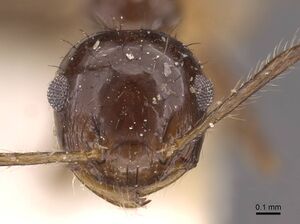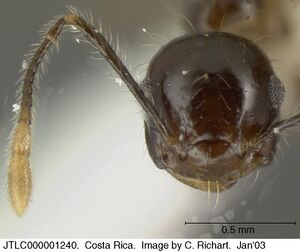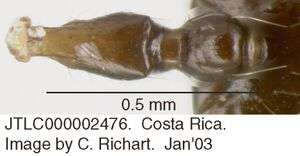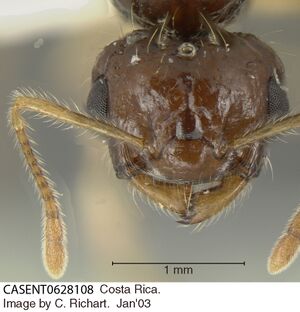Crematogaster longispina
| Crematogaster longispina | |
|---|---|

| |
| Scientific classification | |
| Kingdom: | Animalia |
| Phylum: | Arthropoda |
| Class: | Insecta |
| Order: | Hymenoptera |
| Family: | Formicidae |
| Subfamily: | Myrmicinae |
| Tribe: | Crematogastrini |
| Genus: | Crematogaster |
| Species: | C. longispina |
| Binomial name | |
| Crematogaster longispina Emery, 1890 | |
| Subspecies | |
| |
Nests in small carton nests constructed in wet forest vegetation.
| At a Glance | • Polygynous • Ant garden |
Identification
Longino (2003) - The combination of very long, divergent propodeal spines and abundant erect tibial setae uniquely identify this species. Crematogaster nigropilosa has similar large spines, but the pilosity on the tibiae is appressed.
Keys including this Species
Distribution
Latitudinal Distribution Pattern
Latitudinal Range: 17.24713889° to -64.36°.
| North Temperate |
North Subtropical |
Tropical | South Subtropical |
South Temperate |
- Source: AntMaps
Distribution based on Regional Taxon Lists
Neotropical Region: Colombia, Costa Rica (type locality), Ecuador, French Guiana, Guyana, Nicaragua, Peru, Suriname.
Distribution based on AntMaps
Distribution based on AntWeb specimens
Check data from AntWeb
Countries Occupied
| Number of countries occupied by this species based on AntWiki Regional Taxon Lists. In general, fewer countries occupied indicates a narrower range, while more countries indicates a more widespread species. |

|
Estimated Abundance
| Relative abundance based on number of AntMaps records per species (this species within the purple bar). Fewer records (to the left) indicates a less abundant/encountered species while more records (to the right) indicates more abundant/encountered species. |

|
Biology
Longino (2003) - Crematogaster longispina occurs in very humid conditions in wet forest. Although it occurs at sea level, it is more common at elevations slightly higher, around 500m. It forms small carton nests, usually no more than 10-15cm across, on low vegetation and tree trunks. The carton is very loose and friable, and falls away easily on disturbance. These carton nests often host an array of sprouting epiphytes, and are penetrated by roots from epiphytes growing in the vicinity. Nests are usually packed with workers and brood, one or more physogastric queens (polygyny is common), and scattered coccoid Homoptera on the penetrating roots. Nests are locally abundant, occurring on many adjacent trunks or scattered through low vegetation. The nest dispersion and polygyny suggest polydomy and perhaps unicoloniality. In spite of many observations of nests, I have never observed adult males or alate queens.
Kleinfeldt (1978) studied a colony or colonies of C. longispina at La Selva Biological Station in Costa Rica, investigating its relationship to a common ant garden inhabiting epiphyte, Codonanthe crassifolia (Gesneriaceae).
The site at La Selva where Kleinfeldt carried out her study has been increasingly developed as a laboratory clearing, and the surrounding landscape has seen increasing deforestation. Crematogaster longispina no longer occurs at Kleinfeldt's study site, and in fact appears very rare at La Selva. I have only encountered it near the back edge of the La Selva station property, along a stream margin in a deep forested ravine. This species may require constantly high humidity levels and be particularly sensitive to habitat fragmentation and edge effects, especially at low elevations.
Others commenting on ant gardens in this species include Dejean et al. (2000), Kleinfeldt (1978) (noted as ant-garden initiator), Kleinfeldt (1986), Longino (2003) and Orivel & Leroy (2011).
Life History Traits
- Queen number: polygynous (Frumhoff & Ward, 1992)
Castes
Worker
Images from AntWeb
   
| |
| Syntype of Crematogaster longispina naumannae. Worker. Specimen code casent0908486. Photographer Z. Lieberman, uploaded by California Academy of Sciences. | Owned by MHNG, Geneva, Switzerland. |
   
| |
| Syntype of Crematogaster longispina. Worker. Specimen code casent0902156. Photographer Ryan Perry, uploaded by California Academy of Sciences. | Owned by NHMUK, London, UK. |
   
| |
| Syntype of Crematogaster longispina. Worker. Specimen code casent0904522. Photographer Z. Lieberman, uploaded by California Academy of Sciences. | Owned by MSNG, Genoa, Italy. |
  
| |
| Worker. Specimen code jtlc000001240. Photographer C. Richart, uploaded by University of Utah. | Owned by JTLC. |
 
| |
| Worker. Specimen code casent0193767. Photographer Bonnie Blaimer, uploaded by Curator Bonnie Blaimer. | Owned by BBBC, Bonnie B. Blaimer Collection. |
 
| |
| Specimen code jtlc000002476. . | |
Queen
Images from AntWeb
 
| |
| Queen (alate/dealate). Specimen code casent0628108. Photographer C. Richart, uploaded by University of Utah. | Owned by JTLC. |
Nomenclature
The following information is derived from Barry Bolton's Online Catalogue of the Ants of the World.
- longispina. Crematogaster longispina Emery, 1890b: 53 (w.) COSTA RICA.
- Type-material: holotype worker.
- Type-locality: Costa Rica: Jiménez, 1889 (A. Alfaro).
- Type-depository: MSNG.
- [Also described as new by Emery, 1894k: 57.]
- [Misspelled as longispinosa by Mann, 1916: 443; misspelled as longissima by Santschi, 1918d: 182.]
- Longino, 2003a: 83 (q.).
- Combination in C. (Eucrema): Santschi, 1918d: 182;
- combination in C. (Orthocrema): Emery, 1922e: 136.
- Status as species: Dalla Torre, 1893: 83; Forel, 1899c: 82; Forel, 1907a: 25; Mann, 1916: 443; Santschi, 1918d: 182; Emery, 1922e: 136; Wheeler, W.M. 1923a: 3; Santschi, 1923c: 250; Wheeler, W.M. 1925a: 25; Santschi, 1929f: 88; Kempf, 1972a: 88; Bolton, 1995b: 156; Longino, 2003a: 82 (redescription); Bezděčková, et al. 2015: 117.
- Distribution: Costa Rica, Ecuador, Nicaragua, Peru.
- Current subspecies: nominal plus naumannae, nura.
Type Material
Longino (2003) - Holotype worker: Costa Rica, Prov. Limon, Jimenez Museo Civico di Storia Naturale, Genoa (examined). Unless otherwise noted the text for the remainder of this section is reported from the publication that includes the original description.
Description
Worker
Longino (2003) - HL 0.660, 0.655, 0.761; HW 0.646, 0.634, 0.776; HC 0.593, 0.570, 0.700; SL 0.738, 0.717, 0.812; EL 0.149, 0.150, 0.168; A11L 0.282; A11W 0.106; A10L 0.142; A10W 0.079; A09L 0.083; A09W 0.057; A08L 0.061; A08W 0.049; WL 0.830, 0.798, 0.944; SPL 0.278, 0.309, 0.427; PTH 0.147, 0.142, 0.178; PTL 0.290, 0.276, 0.326; PTW 0.161, 0.170, 0.202; PPL 0.175, 0.147, 0.184; PPW 0.171, 0.159, 0.213; CI 98, 97, 102; OI 23, 23, 22; SI 112, 109, 107; PTHI 51, 51, 55; PTWI 56, 62, 62; PPI 98, 108, 116; SPI 33, 39, 45; ACI 0.79.
Color dark red brown to black, head and gaster darker than mesosoma, tarsi, and terminal 2-3 segments of antenna yellow or at least much lighter brown.
Mandibles smooth and shiny; in full face view anterior margin of clypeus weakly convex; clypeus convex, shiny; face smooth and shiny; scapes smooth and shiny, slightly clavate, with abundant curved erect setae, setae about as long as width of scape; terminal 2-3 segments of antenna gradually lengthening to form club, becoming increasingly densely pubescent, terminal two segments the largest and most conspicuous; face with abundant erect flexuous setae; in full face view with abundant setae projecting from sides and posterior margin of head, both anterior and posterior to eyes; ventral surface of head with moderately abundant suberect setae.
In lateral view, promesonotum elongate, pronotum forming sigmoidal curve as it rises from anterior collar to weakly convex dorsal surface, continuous with anterior half of mesonotum, posterior half of mesonotum dropping steeply to propodeal suture; promesonotum elevated above propodeum; mesonotum with pair of pronounced lateral carinae, rounded and smooth anteriorly, becoming sharper posteriorly and converging to join small lateral carinulae that bridge propodeal suture; dorsal and posterior faces of propodeum differentiated, meeting at an angle; propodeal spines large, long, narrowly acute and spiniform, projecting upward and strongly diverging; side of pronotum always smooth and shining, pronotal dorsum smooth and shining or with faint longitudinal etching; katepisternum smooth and shining or with variably developed faint microareolate sculpture; side of propodeum smooth and shining or with faint microsculpture; dorsal face of propodeum smooth and shining to finely and faintly longitudinally striate; posterior face of propodeum smooth and shining; pair of long erect flexuous setae on pronotal humeri and anterior mesonotum, shorter erect setae scattered over promesonotum, dorsolateral margins of propodeum, and onto propodeal spines; legs with abundant short erect setae, setae shorter than width of tibiae.
Petiole in side view elongate, smooth and shining or with faint microsculpture, with variably developed small anteroventral tooth; in dorsal view, dorsal face of petiole long triangular, strongly and regularly converging anteriorly, widest posteriorly, smooth and shining, with seta projecting from side near spiracle, and 1-2 setae on posterolateral corners; petiole with slight bulge at petiolar spiracle, visible in both dorsal and along ventral margin in lateral view; ventral margin of postpetiole with denticle; postpetiole in dorsal view globular, with 2 pairs erect setae; fourth abdominal tergite smooth and shining or with faint microareolate sculpture, with abundant long flexuous erect setae.
Queen
Longino (2003) - A normal queen (dorsal face of propodeum drops steeply from postscutellum and much of propodeum appears ventral to scutellum and postscutellum); head and mesosoma often covered with wax layer; color red brown, usually with lighter yellow scapes, antenna tips, and legs; head pilosity and sculpture characters as in worker; terminal 5 segments of antenna gradually enlarging to form club, the last two largest and most conspicuous; pronotal dorsum short, perpendicular, forming continuous profile with large mesonotum; propodeal spine variable, low and broadly triangular with blunt tip or somewhat produced with well-defined acute tip; abundant medium length setae on dorsal mesonotum and scutellum, anterolateral pronotum, lower katepisternum, and clustered around base of propodeal spine; femora and tibiae with abundant erect setae; petiole subtriangular in side view, anteroventral tooth small, bluntly obtuse to subacute; in dorsal view, dorsal face of petiole strongly convex posteriorly, strongly tapering anteriorly, with distinct tumosities at petiolar spiracle, with small erect seta projecting laterally near spiracle, and long erect seta on each posterolateral corner; postpetiole with no ventral tooth, subtrapezoidal in dorsal view, smooth and shiny, widest anteriorly, with a dorsal pair and posterior pair of long setae; fourth abdominal tergite smooth and shiny with sparse erect setae; size characters as in Figures.
Karyotype
- 2n = 24, karyotype = 20M+4SM (French Guiana) (Aguiar et al., 2020).
References
- Aguiar, H.J.A.C., Barros, L.A.C., Silveira, L.I., Petitclerc, F., Etienne, S., Orivel, J. 2020. Cytogenetic data for sixteen ant species from North-eastern Amazonia with phylogenetic insights into three subfamilies. Comparative Cytogenetics 14(1): 43–60 (doi:10.3897/CompCytogen.v14i1.46692).
- Albuquerque, E., Prado, L., Andrade-Silva, J., Siqueira, E., Sampaio, K., Alves, D., Brandão, C., Andrade, P., Feitosa, R., Koch, E., Delabie, J., Fernandes, I., Baccaro, F., Souza, J., Almeida, R., Silva, R. 2021. Ants of the State of Pará, Brazil: a historical and comprehensive dataset of a key biodiversity hotspot in the Amazon Basin. Zootaxa 5001, 1–83 (doi:10.11646/zootaxa.5001.1.1).
- Barnett, A.A., Boyle, S.A., Kinap, N.M., Santos-Barnett, T.C.dos, Camilo, T.T., Parolin, P., Fernandez Piedade, M.T., Bezerra, B.M. 2020. Buds, Bugs and Bienniality: The Floral Biology of Eschweilera tenuifolia (O. Berg) Miers in a Black-Water Flooded Forest, Central Amazonia. Forests 11, 1251 (doi:10.3390/f11121251).
- Dejean, A., Corbara, B., Orivel, J., Snelling, R.R., Delabie, J.H.C., Belin-Depoux, M. 2000. The importance of ant gardens in the pioneer vegetal formations of French Guiana. Sociobiology 35: 425-439.
- Emery, C. 1890c. Studii sulle formiche della fauna neotropica. Bull. Soc. Entomol. Ital. 22: 38-80 (page 53, worker described)
- Emery, C. 1922c. Hymenoptera. Fam. Formicidae. Subfam. Myrmicinae. [part]. Genera Insectorum 174B: 95-206 (page 136, Combination in C. (Orthocrema))
- Franco, W., Ladino, N., Delabie, J.H.C., Dejean, A., Orivel, J., Fichaux, M., Groc, S., Leponce, M., Feitosa, R.M. 2019. First checklist of the ants (Hymenoptera: Formicidae) of French Guiana. Zootaxa 4674, 509–543 (doi:10.11646/zootaxa.4674.5.2).
- Khazan, E., Bujan, J., Scheffers, B.R. 2020. Patterns of ant activity and nesting ecology depend on flooding intensity in a Neotropical floodplain. International Journal of Tropical Insect Science (doi:10.1007/s42690-020-00149-0).
- Kleinfeldt, S.E. 1978. Ant-gardens: the interaction of Codonanthe crassifolia (Gesneriaceae) and Crematogaster longispina (Formicidae). Ecology 59: 449-456.
- Kleinfeldt, S.E. 1986. Ant-gardens: mutual exploitation. In: Juniper, B. & Southwood, T.R.E. (Eds.): Insects and the plant surface. Edward Arnold, Oxford, pp. 283-291.
- Longino, J.T. 2003a. The Crematogaster of Costa Rica. Zootaxa 151: 1-150. (page 82, pl. 1, 5 worker, queen described)
- Orivel, J., Leroy, C. 2011. The diversity and ecology of ant gardens (Hymenoptera: Formicidae; Spermatophyta: Angiospermae). Myrmecological News 14: 73-85.
- Przybyszewski, K.R., Silva, R.J., Vicente, R.E., Garcia Freitas, J.V., Pereira, M.J.B., Izzo, T.J., Tonon, D.S. 2020. Can baited pitfall traps for sampling dung beetles replace conventional traps for sampling ants? Sociobiology 67, 376-387 (doi:10.13102/sociobiology.v67i3.5201).
- Santschi, F. 1918d. Sous-genres et synoymies [sic] de Cremastogaster (Hym. Formic.). Bull. Soc. Entomol. Fr. 1918: 182-185 (page 182, Combination in C. (Eucrema) [misspelled here as longissima])
- Santschi, F. 1923c. Solenopsis et autres fourmis néotropicales. Rev. Suisse Zool. 30: 245-273 (page 250, Combination in C. (Orthocrema))
References based on Global Ant Biodiversity Informatics
- Adams B. J., S. A. Schnitzer, and S. P. Yanoviak. 2016. Trees as islands: canopy ant species richness increases with the size of liana-free trees in a Neotropical forest. Ecography doi: 10.1111/ecog.02608
- Adams B. J., S. A. Schnitzer, and S. P. Yanoviak. 2019. Connectivity explains local ant community structure in a Neotropical forest canopy: a large-scale experimental approach. Ecology 100(6): e02673.
- Adams, R.M.M. and J.T. Longino. 2007. Nesting biology of the arboreal fungus-growing ant Cyphomyrmex cornutus and behavioral interactions with the social-parasitic ant Megalomyrmex mondabora. Insectes Sociaux 54:136-143
- Bezdeckova K., P. Bedecka, and I. Machar. 2015. A checklist of the ants (Hymenoptera: Formicidae) of Peru. Zootaxa 4020 (1): 101–133.
- Blaimer B. B. 2012. Acrobat ants go global Origin, evolution and systematics of the genus Crematogaster (Hymenoptera: Formicidae). Molecular Phylogenetics and Evolution 65: 421-436.
- Emery C. 1890. Studii sulle formiche della fauna neotropica. Bull. Soc. Entomol. Ital. 22: 38-8
- Escalante Gutiérrez J. A. 1993. Especies de hormigas conocidas del Perú (Hymenoptera: Formicidae). Revista Peruana de Entomología 34:1-13.
- Fernandes I., and J. de Souza. 2018. Dataset of long-term monitoring of ground-dwelling ants (Hymenoptera: Formicidae) in the influence areas of a hydroelectric power plant on the Madeira River in the Amazon Basin. Biodiversity Data Journal 6: e24375.
- Fernández, F. and S. Sendoya. 2004. Lista de las hormigas neotropicales. Biota Colombiana Volume 5, Number 1.
- Forel A. 1907. Formicides du Musée National Hongrois. Ann. Hist.-Nat. Mus. Natl. Hung. 5: 1-42.
- Franco W., N. Ladino, J. H. C. Delabie, A. Dejean, J. Orivel, M. Fichaux, S. Groc, M. Leponce, and R. M. Feitosa. 2019. First checklist of the ants (Hymenoptera: Formicidae) of French Guiana. Zootaxa 4674(5): 509-543.
- Gibernau M., J. Orivel, J. H. C. Delabie, D. Barabe, and A. Dejean. 2007. An asymmetrical relationship between an arboreal ponerine ant and a trash-basket epiphyte (Araceae). Biological Journal of the Linnean Society 91: 341-346.
- Groc S., J. H. C. Delabie, F. Fernandez, M. Leponce, J. Orivel, R. Silvestre, Heraldo L. Vasconcelos, and A. Dejean. 2013. Leaf-litter ant communities (Hymenoptera: Formicidae) in a pristine Guianese rainforest: stable functional structure versus high species turnover. Myrmecological News 19: 43-51.
- Groc S., J. Orivel, A. Dejean, J. Martin, M. Etienne, B. Corbara, and J. H. C. Delabie. 2009. Baseline study of the leaf-litter ant fauna in a French Guianese forest. Insect Conservation and Diversity 2: 183-193.
- INBio Collection (via Gbif)
- Kempf, W.W. 1972. Catalago abreviado das formigas da regiao Neotropical (Hym. Formicidae) Studia Entomologica 15(1-4).
- Leponce M., J. H. C. Delabie, J. Orivel, J. Jacquemin, M. Calvo Martin, and A. Dejean. 2019. Tree-dwelling ant survey (Hymenoptera, Formicidae) in Mitaraka, French Guiana, in Touroult J. (ed.), “Our Planet Reviewed” 2015 large-scale biotic survey in Mitaraka, French Guiana. Zoosystema 41 (10): 163-179.
- Longino J. T. L., and M. G. Branstetter. 2018. The truncated bell: an enigmatic but pervasive elevational diversity pattern in Middle American ants. Ecography 41: 1-12.
- Longino J. T., J. Coddington, and R. K. Colwell. 2002. The ant fauna of a tropical rain forest: estimating species richness three different ways. Ecology 83: 689-702.
- Longino J. et al. ADMAC project. Accessed on March 24th 2017 at https://sites.google.com/site/admacsite/
- Longino, J.T. 2003. The Crematogaster (Hymenoptera, Formicidae, Myrmicinae) of Costa Rica. Zootaxa 151:1-150
- Lopes M. C., G. P. A. Lamarre, C. Baraloto, P. V. A. Fine, A. Vincentini, and F. B. Baccaro. 2019. The Amazonas-trap: a new method for sampling plant-inhabiting arthropod communities in tropical forest understory. Entomologia Experimentalis et Applicata https://doi.org/10.1111/eea.12797
- Ottonetti L., L. Tucci, F. Frizzi, G. Chelazzi, and G. Santini. 2010. Changes in ground-foraging ant assemblages along a disturbance gradient in a tropical agricultural landscape. Ethology Ecology & Evolution 22: 7386.
- Santschi F. 1929. Mélange myrmécologique. Wiener Entomologische Zeitung. 46: 84-93.
- Siqueira de Castro F., A. B. Gontijo, P. de Tarso Amorim Castro, and S. Pontes Ribeiro. 2012. Annual and Seasonal Changes in the Structure of Litter-Dwelling Ant Assemblages (Hymenoptera: Formicidae) in Atlantic Semideciduous Forests. Psyche doi:10.1155/2012/959715
- Siqueira de Castro F., A. B. Gontijo, W. Duarte da Rocha, and S. Pontes Ribeiro. 2011. As comunidades de formigas de serapilheira nas florestas semidecíduas do Parque Estadual do Rio Doce, Minas Gerais. MG.BIOTA, Belo Horizonte 3(5): 5-24.

